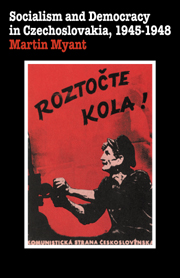Book contents
- Frontmatter
- Contents
- Acknowledgements
- Abbreviations
- Introduction
- 1 The development of the Communist Party of Czechoslovakia
- 2 War and occupation
- 3 The national revolution
- 4 The national revolution in Slovakia
- 5 Czech political parties
- 6 The Gottwald government
- 7 Deepening divisions
- 8 Prelude to February
- 9 The February crisis
- 10 Post-February Czechoslovakia
- Notes
- Bibliography
- Index
10 - Post-February Czechoslovakia
Published online by Cambridge University Press: 07 October 2011
- Frontmatter
- Contents
- Acknowledgements
- Abbreviations
- Introduction
- 1 The development of the Communist Party of Czechoslovakia
- 2 War and occupation
- 3 The national revolution
- 4 The national revolution in Slovakia
- 5 Czech political parties
- 6 The Gottwald government
- 7 Deepening divisions
- 8 Prelude to February
- 9 The February crisis
- 10 Post-February Czechoslovakia
- Notes
- Bibliography
- Index
Summary
CONSOLIDATION OF POWER
Changes in power throughout society were brought about to a great extent by Action Committees. They were presented as the organs of the new National Front, but the practical details of their size, exact composition and relationship to other institutions were all left vague. Only the essential principle was made clear and directives from the Ministry of the Interior left little doubt that they were to be formed, and to remain, under Communist control: their immediate role was to reflect and consolidate the Communist Party's newly won power regardless of any normal democratic procedures.
They were not to be elected organs and control was to be exercised only from above – even the calling of public meetings was discouraged. Nevertheless, they were apparently the ‘authorised’ spokesmen of the will of the Czechoslovak people and had enormous powers of discretion: they were assured that decisions, provided they had been ‘correct’, would be retrospectively approved by law.
Their first task was to implement a purge. At some levels, however, this was done by direct administrative measures. The Communist mayor of Prague simply requested the removal of all representatives of the other three parties from the National Committee and the Ministry of the Interior quickly approved the measure! Changes then went down to lower levels. The official figures suggest that of 9419 employees in the political administration, 526 were removed, while out of 5600 in Regional administration only 28 were sacked. Overall, in all spheres of life, the immediate post-February purge probably affected 20,000–30,000, including those demoted or prematurely pensioned off.
- Type
- Chapter
- Information
- Socialism and Democracy in Czechoslovakia1945-1948, pp. 219 - 242Publisher: Cambridge University PressPrint publication year: 1981



